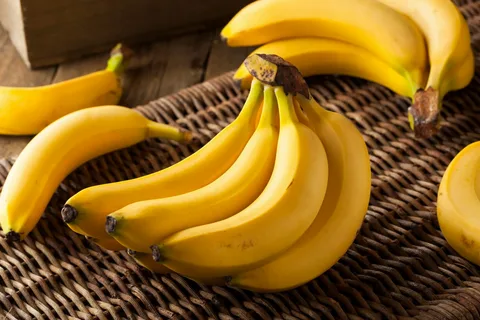Introduction
Bananas are not only delicious but also packed with essential nutrients that can benefit your health in various ways. This humble fruit, readily available in most parts of the world, is a great addition to your daily diet. In this article, we'll explore the nutritional benefits of bananas.
Bananas are an excellent source of potassium, a mineral that plays a crucial role in maintaining proper heart and muscle function. Consuming potassium-rich foods like bananas can help regulate blood pressure and reduce the risk of stroke.
Moreover, bananas are a good source of dietary fiber. One medium-sized banana contains about 3 grams of fiber, which aids digestion and helps prevent constipation. Fiber also contributes to a feeling of fullness, making bananas a satisfying snack choice.
Additionally, bananas are rich in essential vitamins and minerals, including vitamin C, vitamin B6, and manganese. Vitamin C is known for its immune-boosting properties, while vitamin B6 is important for brain development and function. Manganese supports bone health and helps the body metabolize nutrients.
Bananas are also a convenient on-the-go snack. They come in their own natural packaging, making them easy to carry in a bag or lunchbox. Their natural sweetness can satisfy your sweet tooth in a healthier way than sugary snacks.
In conclusion, bananas are a nutritional powerhouse. Incorporating them into your diet can provide numerous health benefits, from maintaining heart health to aiding digestion. So, the next time you're looking for a quick and nutritious snack, reach for a banana!
The History and Cultivation of Bananas
Bananas, one of the world's most popular fruits, have a rich history and an intriguing journey from their origins to your local grocery store. In this article, we'll delve into the history and cultivation of bananas.
Bananas are believed to have originated in Southeast Asia, in the region that includes Malaysia, Indonesia, and the Philippines. They have been cultivated for thousands of years, with evidence of their consumption dating back to at least 5000 BCE.
The cultivation and spread of bananas can be attributed to various civilizations. Arab traders are thought to have introduced bananas to Africa and the Middle East, while European explorers encountered them during their voyages to the Caribbean and the Americas.
In the 19th century, bananas gained popularity in the United States. American entrepreneurs like Lorenzo Dow Baker and Andrew Preston, along with a partnership with the Boston Fruit Company, played a significant role in popularizing bananas by importing them from the Caribbean.
Today, bananas are grown in over 150 countries, with the largest producers being India, China, and the Philippines. They are typically grown in tropical and subtropical regions and are a vital source of income and nutrition for many communities.
Conclusion
Banana cultivation involves planting banana plants, which are technically large herbs, rather than trees. The plants produce clusters of fruit that grow in "hands." These hands are harvested when the bananas are green and then ripen off the plant.
In conclusion, bananas have a fascinating history that spans thousands of years and continents. Their journey from Southeast Asia to becoming a global staple is a testament to human ingenuity and the interconnectedness of our world.
Fun Facts About Bananas
Bananas are not only delicious and nutritious but also incredibly interesting. In this article, we'll explore some fun and surprising facts about bananas that you might not have known.
- Bananas Are Berries: While you might consider bananas to be fruits, they are technically classified as berries. In botanical terms, berries are fruits produced from a single ovary, and bananas fit this definition.
- Variety of Colors: Bananas come in various colors, including yellow, red, and even purple. The most common variety is the yellow Cavendish banana, but other types, like the red banana, offer different flavors and nutritional profiles.
- Radioactive Bananas: Bananas contain a small amount of potassium-40, which is a radioactive isotope of potassium. However, the levels are so low that you'd need to eat thousands of bananas in a short time to experience any harmful effects.
- Banana Republic: The term "banana republic" was coined in the early 20th century to describe countries in Central America and the Caribbean that heavily relied on banana exports. It has since come to refer to politically unstable nations dependent on a single resource.
- Banana Art: Some artists use banana peels as a canvas for their artwork. They carve intricate designs or create temporary sculptures, showcasing the versatility of this fruit.
- Rich in Potassium: Bananas are often associated with potassium. They are an excellent source of this mineral, which is essential for muscle function, nerve signaling, and maintaining healthy blood pressure.
- Natural Stress Reliever: Bananas contain tryptophan, an amino acid that can help your body produce serotonin—a natural mood stabilizer and stress reducer.
- Banana Etymology: The word "banana" is believed to have originated from the Arabic word "banan," which means finger. Vilitra 40 and Sildalist is a reference to the like shape when unpeeled.
- World's Most Popular Fruit: Bananas are the most consumed fruit in the world. They surpass apples, oranges, and any other fruit you can think of in terms of global consumption.
- Biodegradable Packaging: Banana peels are not only edible but also have practical uses. They can be used to polish shoes, whiten teeth, and even nourish plants in your garden.
In conclusion, bananas are not just a tasty snack; they are a fascinating fruit with a rich history and a wide range of uses and trivia. Whether you enjoy them in smoothies, on top of cereal, or as a standalone snack, bananas are a versatile and delightful addition to your diet.


